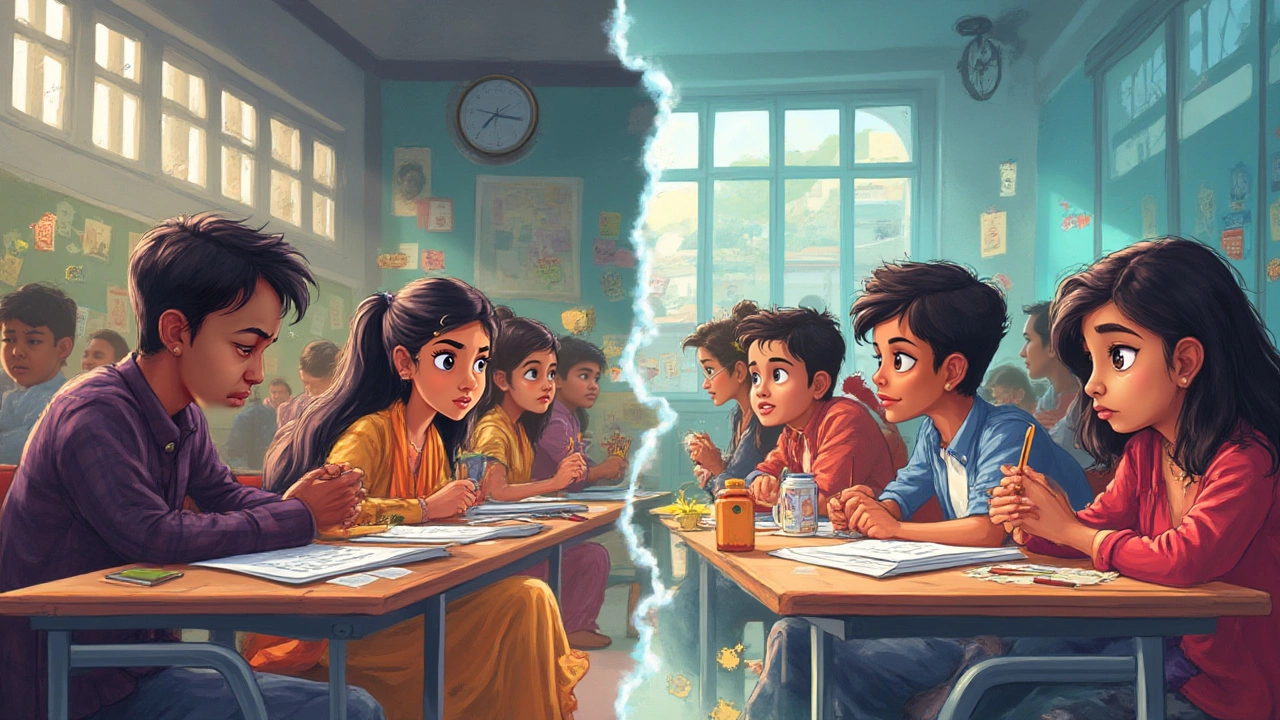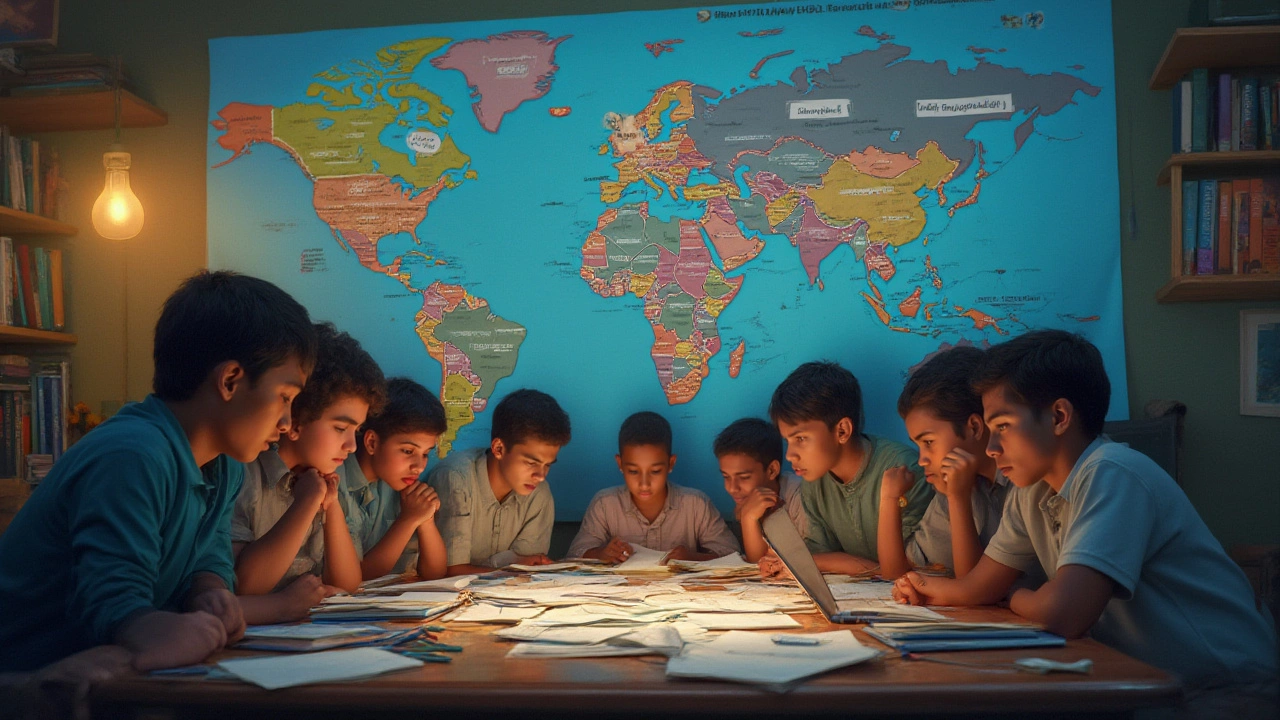If you thought pulling an all-nighter for finals was bad, wait until you get a look at what students go through in some countries. Academic stress isn’t spread equally across the globe. While some education systems are pretty laid back and flexible, others are so intense, they can feel more like bootcamp than school. People debate which country truly has the hardest study environment, but a few contenders keep coming up, and it’s easy to see why. Imagine spending twelve hours a day at school, being tested on tiny details all the time, and having your entire future hinge on maybe one set of exams. Sounds wild? Let’s get into where in the world students have it toughest—and what you’d actually face if you studied there.
Countries With the Toughest Education Systems
South Korea, Japan, China, Singapore and India are the usual suspects whenever you ask about brutal education systems. They all have mind-boggling stats, national obsessions with grades, and stories about student pressure so intense there are entire industries built around tutoring and test prep.
Take South Korea. The country’s students famously survive on four hours of sleep, thanks to hagwons—cram schools that keep kids learning long after the sun goes down. The Korean CSAT, or Suneung, basically puts the country on pause: offices open late, planes stop flying so students aren’t distracted. Only about 3% of test-takers get into the top three SK universities, known as SKY. The pressure for perfect scores leads to some of the highest teen stress and depression rates in the world. Mental health services are almost a necessity for high schoolers here.
China is no less intense. Every June, nearly 12 million Chinese students take the Gaokao, a two-day test that decides which university you get into. Some students will study for 12 hours a day, every day, for months to prepare. Families often move to districts with better schools years ahead of the exams. Parents spend whole salaries on tutors—some cram schools charge fees that rival college tuition. It’s so competitive that only about 2% of students secure spots at elite universities like Tsinghua or Peking. The pressure isn’t just academic; it influences family life, sleep, everything.
Japan is known for its Juken Jigoku, or ‘exam hell’. After school, students head straight to juku—after-school classes that prep for the next round of national tests. Even sustainable sleep becomes a luxury during middle and high school years as kids juggle homework, club activities, and those all-important entrance tests. A spot at the University of Tokyo is pretty much won or lost years before a student gets to campus, depending on their high school test scores.
Singapore’s education system is a global benchmark for test results—and also for how high the expectations are. Kids are streamed into academic tracks by the time they turn 12, and switching tracks later is rare. If you don’t fit into the system, extra tuition and weekend classes await. Even primary school students can have more homework than many European high schoolers.
India is a country of contrasts, but anyone who’s ever prepared for the IIT-JEE (the entrance exam for the country’s best engineering colleges) will tell you: nothing on Netflix captures what it feels like to study here. Indian students deal with a double whammy: massive class sizes and the need to outscore over a million peers for a handful of elite places. Test pressure here isn’t just academic—it’s woven into cultural expectations about status and success. That’s one reason why coaching centers are a booming business, and why stories of exam stress dominate news headlines every summer.
| Country | Famous Exam | Applicants Annually | Acceptance Rate (Top School) | Average Study Hours/Day (Senior Year) |
|---|---|---|---|---|
| South Korea | CSAT/Suneung | Over 500,000 | SKY Univ: ~3% | 10 |
| China | Gaokao | ~12 million | Tsinghua/Peking: ~2% | 12 |
| Japan | National Center Test | ~500,000 | U. Tokyo: <1% | 8 |
| Singapore | PSLE & O-Levels | ~40,000 (PSLE) | NUS: ~5% | 6-8 |
| India | IIT-JEE | ~1.2 million | IIT: <1% | 10-12 |
What’s so wild is that all of these countries also send plenty of students abroad—many just want a breather! So what’s driving it? It’s competitiveness, a deep belief that academic success equals life success, limited university spots, and the weight of social and family expectations. If you thrive on structure and high stakes, these systems might push you to your limits and beyond. If not, it can feel overwhelming fast.

What Makes a Country the Hardest to Study In?
It’s easy to say it’s all about the length of school days or tough tests, but ‘hardest’ is complicated. What really pushes students: unforgiving exams, lack of flexibility, high expectations from family, or maybe fierce peer competition? Let’s break it down.
First, look at the culture. In South Korea or China, failing a test can feel like letting down your entire family. Success stories of friends, cousins, and neighbors only fuel the pressure. Students carry this weight from an early age, sometimes before they even hit double digits. They grow up knowing their actions today will shape their job market chances years ahead.
Second, consider the rules. In Japan, you pass or fail based on national exams. Mess up, and your choices narrow—sometimes for life. In India, a single year’s exam slip can mean repeating an entire year, or missing a shot at your dream university. Singapore bundles every kid into tracks based on tests at age twelve, and there are very few second chances to jump tracks later. These rules leave little room for mistakes. If you’re used to systems where you can build your GPA over years or catch up with summer school, that’s a real shock.
Next, think about resources. Students in these countries often rely on extra tutoring after hours. In Korea, it’s common for elementary kids to spend three hours in hagwons—private academies—every day. In India, the coaching industry for IIT-JEE and NEET (for aspiring doctors) is so massive it’s worth over a billion dollars. It’s not surprising that, according to UNICEF, Korean students spend more days in school than most of the world (over 220 days per year).
None of this even touches on the physical and mental health costs. Studies by the Korea Institute for Health and Social Affairs show high schoolers there average less than six hours of sleep during exam periods. In China, a 2023 report found about 70% of high school students in top cities suffered from moderate or severe stress, and almost half reported symptoms of anxiety. In Singapore, the term ‘kiasu’ (fear of missing out or being left behind) reflects a national anxiety around academic competition. Even peer-reviewed journals like The Lancet have flagged alarm bells about youth depression in these countries, tracing a big part of the problem to pressure cooker schools.
But here’s something people forget: what’s ‘hard’ isn’t always universal. Western students sometimes find Asian systems incredibly strict, with little attention paid to creativity or personal time. On the other hand, many local students succeed because that’s the only system they’ve ever known—they just adapt, in their own way. If you stumble into one of these education systems unprepared, though, it can feel crushing. And let’s be honest—plenty of locals feel the same way.
Want hard numbers? In 2024, the OECD’s Education at a Glance survey showed that Korean and Japanese students scored highest in hours spent in class and on homework, with China, India, and Singapore not far behind. But stress levels in these countries remained at least 30% higher than those in Germany, France, or Canada, where systems allow for more flexibility and time off.
- In South Korea, youth suicide rates spike every November, right after CSAT results come out.
- Japanese high schoolers do an average of 3-5 hours of homework per night—compared with less than an hour for US students.
- Chinese students often start prepping for Gaokao at age 12 or 13—five years before the test actually happens.
- India’s IIT-JEE sees over a million students each year competing for just 16,000 seats.
- Singapore’s Primary School Leaving Exam (PSLE) can determine, at age 12, what kind of job you’re likely to land after graduation. Pressure starts early and doesn’t let up.
All these factors—extreme competition, little room for error, the ritual of extra lessons, the specter of shame or failure—come together to create an intensely hard environment for anyone studying in these countries. If you’re thinking about studying abroad, it’s smart to dig in and understand what you’re getting into.

Surviving and Thriving in the Hardest Study Environments
So, what should you do if you land in one of these hardcore environments? You can’t just schedule a spa day and call it good. Surviving those systems—and maybe even thriving—takes a mix of clever strategies, mental health awareness, and knowing when to ask for help.
First tip: embrace structure. Upping your organization game is a must where you have wall-to-wall classes, extra lessons, and surprise quizzes at every turn. Get used to using planners, digital reminders, or even good old sticky notes. Setting micro-goals can really help break huge study loads into daily wins. There’s a reason Asian students rely so much on routines—they work, especially when time is tight.
Second: don’t skimp on sleep. Pulling an all-nighter might sound like a rite of passage, but research from Seoul National University in 2023 showed that South Korean teens who managed at least 7 hours a night performed up to 12% better on finals, compared to those who lost more sleep. Ditch the notion that exhaustion equals hard work—bragging about not sleeping is out, body-brain health is in.
Third: try to find your community. Yes, everyone’s competing, but study groups can be a lifesaver. You’ll get new perspectives, share resources, and sometimes even find emotional support. In Japan and Singapore especially, students who felt ‘part of a group’ reported being 20% less stressed than solo students, according to a JSTOR Education study.
Fourth: learn to switch off, even if just for ten minutes. Meditation apps, neighborhood walks, or even five minutes with a funny cat video can work wonders. In China, some Gaokao prep schools have introduced mandatory nap or game sessions, after seeing results jump for students who get short breaks.
Fifth: don’t hesitate to talk to someone—anyone—if the pressure’s crushing you. Mental health stigma is real in these cultures, but that’s slowly changing. Universities in Seoul, Beijing, Tokyo and Singapore now offer counseling services geared toward academic stress. International students, in particular, can seek out student clubs or consulate support groups. You’re not weak for seeking help; you’re strategic.
Sixth: work on time management before you arrive. Download time-tracking apps, practice managing your tasks, and get used to turning off distractions. Students who master their tech tools—from calendar reminders to focus apps—find it easier to handle fast-paced, high-pressure environments. Smart prep starts before your flight lands.
Seventh: know your endgame. It’s easy to get lost in the weeds, memorizing facts for this week’s test or next month’s entrance exam. Remind yourself of why you chose this path, what you actually want to get from the system, and what other opportunities you could explore if things don’t go to plan. That clarity helps you bounce back from setbacks, big or small.
Last but not least, celebrate your progress. Success in ultra-intense education systems can feel like an endless finish line keeps moving, but daily wins—finishing an assignment, nailing a quiz, even getting a question right you struggled with—are worth marking. It keeps motivation alive when the pressure’s piled high.
If you’re reading this and feeling anxious, remember: students survive—and even thrive—in these environments every day. They develop incredible grit, time management, and focus. But it’s no joke — these countries really do make studying hard. If you’re ready for the challenge, you just might come out the other side tougher (and maybe a bit more ambitious) than when you started. If not? There’s wisdom in recognizing when an education system just isn’t the right fit—and that’s okay too.
